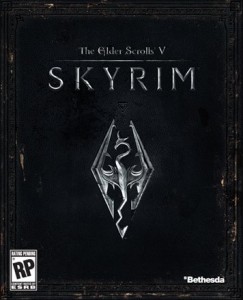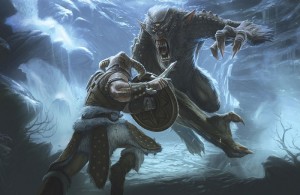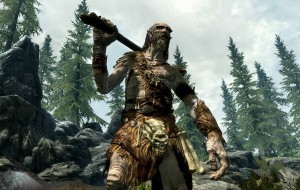This writer will admit that it was incredibly hard to remain objective for this review, for a reason that may be quite unpopular on this site in fact: Emmori loves Western RPGs more than their Japanese cousins, at least for the past few generations of consoles. This could be blamed on any number of reasons: art design differences, storytelling structure, characterization, a dislike of grinding, or maybe simply because of a crippling case of ethnocentrism. Games like Mass Effect and Star Wars: Knights of the Old Republic have always appealed to this writer more than game series such as Final Fantasy and Disgaea ever could. But despite all of this, it may make for a better review. After all, what better to invoke higher standards of criticism than a game that is hyped to set new standards in a favored genre?
The subject of hype, of course, being Betheseda Game Studios’ newest addition to the infamous Elder Scrolls saga: The Elder Scrolls V: Skyrim. Set in the titular land of Skyrim 200 years after the events of the previous game (The Elder Scrolls IV: Oblivion) the game focuses on the player-named main character, a fugitive that has been sentenced to death amidst a civil war that engulfs the land. After the player’s execution is interrupted by a semi-convenient attack on the town by a dragon, the player escapes and make his way into the open world of Skyrim, where his adventure unfolds. The player soon learns that their character is a mythic being known as the “Dragonborn”: the ultimate dragonslayer, and prophecized savior of the world. Although the main plot is indeed interesting enough to warrant playing through, the game (like its predecessors) does not make the player focus on or even pay attention to the main storyline. The game is a giant, open sandbox with a huge number of quests and places to explore, some of which come with their own sets of minor plots and story archs.
The player-made Dragonborn himself (or herself) is not characterized by then game. Rather, it is up to the player to decide how the voiceless Dragonborn reacts to a situation or approaches a problem. Other characters are different, however. Although the voice acting is perhaps the best it has been in an Elder Scrolls game, Skyrim‘s non-player characters all suffer from somewhat wooden voice acting, which is especially noticeable in extreme situations. This occasionally leads to somewhat humorous, yet flow-breaking moments; villagers may find themselves locked in a life-or-death battle with a dragon and emerge victorious, but with bodies of their friends strewn about, but will show no sign of worry or anguish – except for when they stop to look at and ponder the bodies.
The gameplay of Skyrim has been drastically improved and evolved since Oblivion. Though many of the series’ classic features–such as leveling individual skills to level up, enemies that grow stronger as the player does, and crafting and improving equipment–make a return, Skyrim has streamlined combat and gameplay to remove unnecessary features, making way for new and interesting features. Many skill trees have been consolidated and combined, so that making a character with a certain set of skills is easier. Gear no longer becomes damage with use, alleviating the need to repair equipment at annoying intervals. Playing the game in a third-person view, as opposed to the classic first-person view, has been altered and improved as to be useful. Skyrim has also let players fully customize their character by removing classes from the game, no longer punishing characters for choosing a race or trying to level a skill that is counter-intuitive to a class’s purpose. The game also features the addition of perks that improve abilities and allow a character to specialize even further in one or several character directions, no doubt borrowed from Bethesda’s previous Elder Scrolls-eque Fallout series. And finally, the inclusion of giving player the ability to assign different commands and items to separate hands allows players to experiment with and develop strategies and playstyles, such as allowing the player to wield two spells, a sword and shield, two weapons, or any combination of these. There are many bugs and glitches in the game, but few detract from the experience of the game to call it a problem. Combat feels much more fluid in Skyrim than than ever, and as such the gameplay is, in this reviewer’s opinion, the best in the Elder Scrolls series to date.
As a primarily open-ended RPG, one should hope that Skyrim‘s environments should be beautiful and wondrous to look at. And like its predecessor Oblivion, the land of Skyrim is indeed marvelous. For a game set in a wintry, harsh landscape, Skyrim is incredibly detailed and verdant, with several areas that are distinct in atmosphere. Even the dungeons the player must traverse are creepy and moody, with dim illumination and ancient-looking decor that dot the dangerous depths of caverns and fortresses. The game’s soundtrack is subtle and rarely calls attention to itself, only helping to strengthen the mood; triumphant music plays when a discovery is found or a level is gained, calm music plays in peaceful towns, and fast-paced war-drums play whenever an enemy charges or a dragon roars in the distance. Players may rarely wish to utilize the game’s fast-travel system, so that they may explore and take in the landscape of Skyrim fully.
The Elder Scrolls V: Skyrim is an excellent game and players should feel excellent for playing it. It is a big, beautiful world filled with enough things to do to keep even the most completionistic of gamers occupied and entertained for a very long time. It is definitely worth a purchase, especially for those with little to no experience with the Elder Scrolls series that are interested in what all of the fuss is about. Skyrim is available now on Steam, as well as on Playstation 3 and Xbox 360, so go, and play it with utmost confidence in your purchase!


